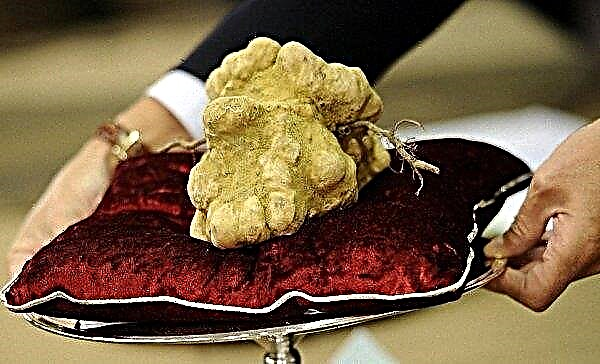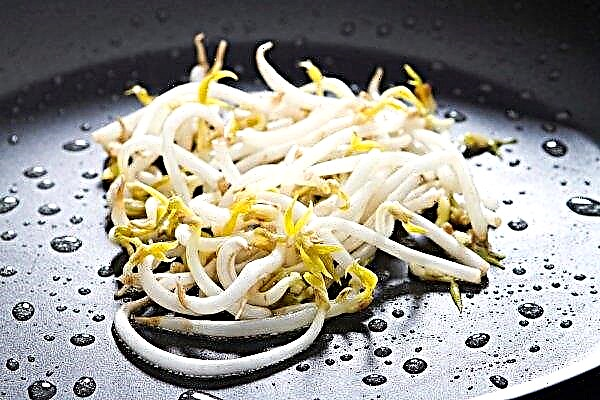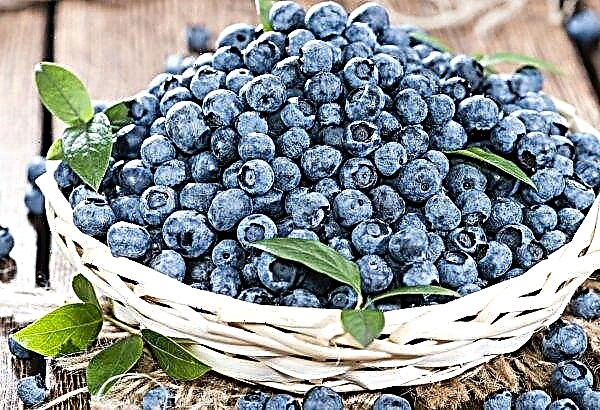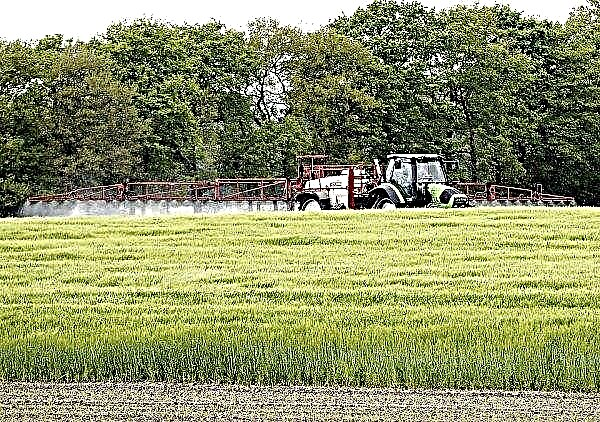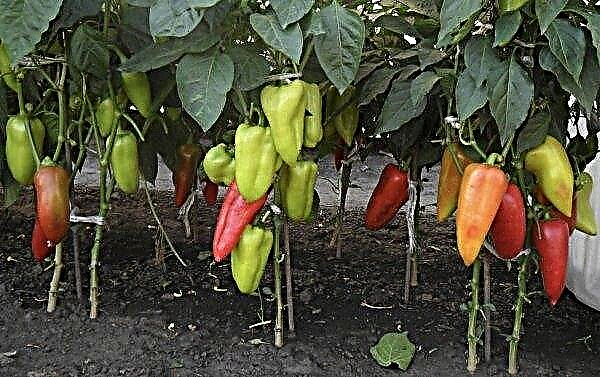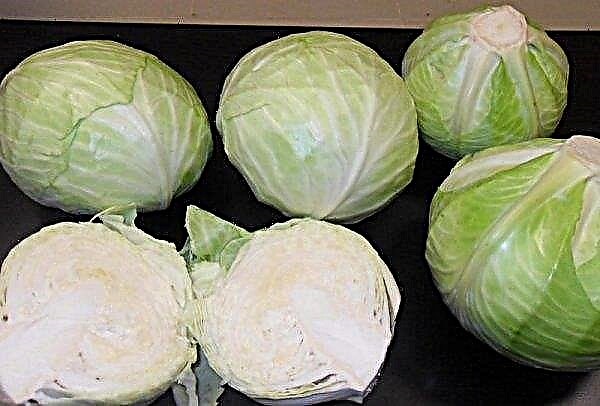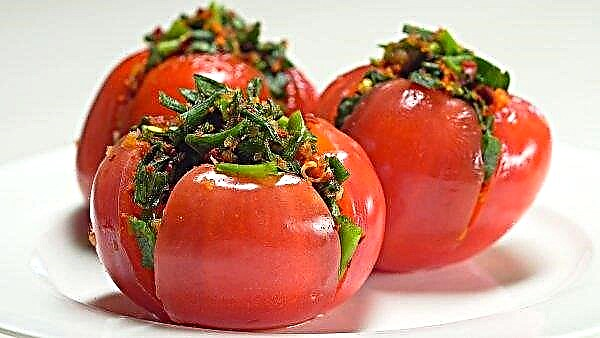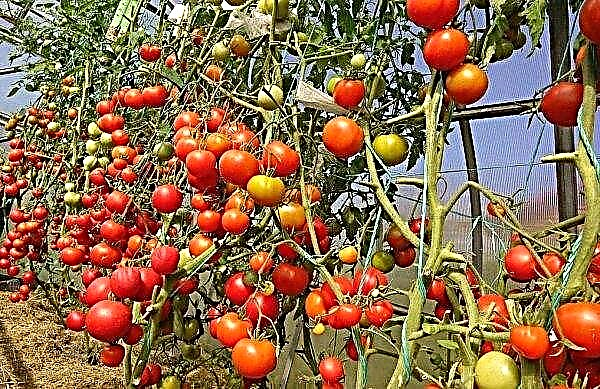Healthy plants have a corresponding appearance, and when the gardener is faced with a phenomenon such as yellowing of the leaves of pepper, he begins to show concern and look for the cause. This phenomenon is called plant chlorosis and can be caused by various factors. We learn what can cause yellowness of pepper leaves in the greenhouse, what should be done and how to avoid it.
Why do peppers turn yellow leaves in the greenhouse
There is far from one reason that can cause pepper chlorosis. It is important at the same time to correctly identify the reason in order to take appropriate measures and not remain without a crop.
Improper growing conditions
Foliage may turn yellow if peppers are surrounded by an unsuitable environment.
These factors include the following:
- Temperature condition. Too early planting or return frosts can reduce the temperature tolerance for normal plant development. Peppers do not tolerate temperature drops up to + 12 ° C, they stop growing, the process of assimilation of elements is disturbed and they have yellowing. Negative effects in the greenhouse can also cause drafts during ventilation. Temperature conditions may not be maintained in insufficiently isolated buildings.
- Light mode. The greenhouse should be placed in a bright place, since shading interferes with photosynthesis. The scorching rays of the sun can also be a negative factor, especially in relation to only the seedlings that are not accustomed to the sun. Young plants are recommended to be covered from the active sun and accustomed to the sun's rays gradually. Daylight hours should be at least 10 hours. This is often true for plants planted in a heated greenhouse in January-February, when the day is still too short.
- Thickening of landings. Too high planting density leads to a lack of elements for feeding bushes. Everything else, plants begin to obscure each other, and there is a lack of light.
 Only planted seedlings can turn yellow due to the stress of the transplant. Usually this phenomenon itself goes away after some time.
Only planted seedlings can turn yellow due to the stress of the transplant. Usually this phenomenon itself goes away after some time.Did you know? Plant chlorosis can occur due to mutations and be inherited. This feature is often used by breeders to breed variegated varieties. ornamental crops.
Improper care
To the fact that the leaves of the pepper became yellow can lead to such errors in the care of it:
- Wrong watering. Pepper refers to moisture-loving crops. Lack of moisture with insufficient watering leads to drying out of the plant. However, excessive waterlogging leads to rotting of the roots and death of the plant. Hosing cold water with water is a great stress for this crop, especially during cool weather.
- Inaccurate loosening of the soil. When loosening, one should be careful and not to zeal too much so as not to damage the roots of the plants. Loosening is necessary, since in the absence of loosening, a hard crust may form on the soil, which will interfere with the plant's normal development and assimilation of elements.
- Lack of necessary fertilizing. In order for the plant to develop normally and bear fruit, it is necessary to do the required elements at the appropriate time. The soil before planting should also be prepared and organic fertilizers applied to it.
Inappropriate soil composition
An important factor for peppers is the quality of the soil in the greenhouse. This crop does not grow well on heavy clay soils. With a lack of air, the assimilation of nutrition by the root system is difficult. Deteriorating ability of plants to absorb nutrients from the soil inappropriate soil acidity.
With a lack of air, the assimilation of nutrition by the root system is difficult. Deteriorating ability of plants to absorb nutrients from the soil inappropriate soil acidity.
Important! The optimum acidity for pepper is considered to be 6–6.6 pH. Chalk, slaked lime, ash, dolomite flour is added to too acidic soil.
The best soil for pepper is light loam or sandy loam with a high content of nutrients.
The foliage of peppers turns yellow when there are deficiencies or an overabundance in the soil of the greenhouse of such elements:
- Nitrogen. The plant is smaller, chlorosis is observed. The veins and adjacent areas turn yellow first. It is observed on soils of poor chernozem.
- Potassium. It is characterized by the appearance of a yellowish border on the leaves, which appears first from the top of the leaf plate. Subsequently, this area becomes brown and dries, the edges curl. These processes usually begin on foliage at the bottom of the bush. Potassium deficiency is found on sandy soils and sandy loams.
- Calcium. First of all, young leaves turn yellow - they become pale and curl. The death of the apical kidney and roots occurs. This leads to poor absorption of other elements, and there are signs of a lack of other substances. Calcium deficiency occurs in acidic soils and with an excess of nitrogen, potassium and magnesium. Excess calcium also leads to impaired absorption of elements and chlorosis, but it appears between the veins.
- Magnesium. This element is involved in photosynthesis, and with a lack of it, yellowing is observed between the veins. The veins themselves and the surrounding areas remain green. The process manifests itself from the lower leaves and gradually moves up. With an excess of magnesium, calcium is poorly absorbed and yellowing is associated with a lack of calcium.
- Sulfur. Young leaves turn yellow first. The signs are very similar to a lack of nitrogen, but the brightened leaves do not crumble. With an excess of sulfur, the leaves may turn yellow from the edges.
- Gland. This element is involved in photosynthesis, and its lack manifests itself as chlorosis between the veins, first on young leaves, then on older ones. It is usually observed on alkaline soils.
- Manganese. Lack of manganese is usually found on alkaline soils when irrigated with hard water. It manifests itself in the fact that the area between the veins acquires a yellow-green color, the leaf becomes mottled. Starts with the bases of young leaves. Excess occurs in acidic soils and is manifested by chlorosis between the veins.
- Molybdenum. Participates in photosynthesis and its deficiency is expressed in the appearance of yellow spots between the veins or along the edge of the leaf plate. The process begins on old foliage and is usually found on acidic soils.

Diseases and pests
Chlorosis of pepper leaves can be infectious. Most often, peppers in greenhouse conditions are affected by a black leg, Septoria, dry or brown spotting, gray rot, sclerotiniosis or late blight, verticillous or Fusarium wilt. These diseases are of fungal, viral or bacterial origin.
Did you know? The largest single greenhouse operates in the UK. It consists of two combined domed rooms. They grow more than a thousand different plants, including exotic ones.
They can also be affected by pests. Yellowing of the bush of pepper can occur due to the fact that the wire system, the bear, or the caterpillar of the scoop have undermined the root system. Through openings during airing, pests such as aphids, spider mites, nematodes, thrips and slugs can climb and spoil the leaves.
As a result of their activity, the foliage has an unhealthy appearance and may turn yellow.
What to do and how to process peppers
After determining the cause of yellowing, proceed to eliminate it. To do this, you can use different tools and techniques.
Important! Be sure to follow the recommended dosage when using any chemical product. Any excess of the nutrient can adversely affect the development of the plant.
Chemicals
To combat the yellowing of the foliage of pepper bushes, chemicals are often used:
- When there is a lack of nutrients such as iron and manganese, the bushes can be fed with iron sulfate or Agrovit, and you can also use the Kemira product. The lack of many nutrients can be made up with the help of mineral complex fertilizers such as Nitroammofoska.
- When sunburns appear on leaflets and for better adaptation of seedlings to new conditions, the plant can be supported by spraying with Epin.
- The problem of excess moisture and decay of the root system can be solved by adding “Fitosporin” or “Trichodermin” into the soil.
- When fusarium is detected, Benazol and Fundazol are used to spray chemical agents.
- Against many fungal diseases that can cause yellowness of the leaves, the treatment with the Bordeaux mixture or with the Kuproksat chemical preparation, which contains copper, helps well.
- When identifying insect pests, which, with their activity, withering and yellowing of foliage, use insecticidal preparations such as Fitoverm, Aktara.
- When aphids are detected, the chemical means "Actellik" or "Karate" are used.

Folk remedies
To repel insect pests, you can plant marigolds, marigold, garlic between the beds. The specific smell of these plants will scare away pests. To reduce the risks of many pests and a number of diseases, you can periodically spray with infusions of garlic and onions.
To eliminate spider mites at an early stage of appearance, you can treat the leaves with medical alcohol or a soap solution. Against such pests, you can use spraying with a decoction of tobacco dust. To do this, 0.5 kg of this substance is infused in 10 liters of water for 24 hours, and then the solution is brought to a boil.
After cooling, filter and dissolve 1/5 of the pre-ground laundry soap (for better adhesion). Before use, the resulting solution is diluted with water in a ratio of 1 to 1.
For top dressing, to eliminate yellowing of the foliage, natural organic fertilizers are perfect - this is rotted manure or bird droppings. Such organic matter contains enough nitrogen, which positively affects the deciduous cover. With a lack of calcium, you can use crushed egg shells that sprinkle soil around the plants.
The use of wood ash as a fertilizer will make the plant more resistant to lower temperatures. In addition, it contains many elements necessary for the plant and slightly removes the acidity of the soil.
Proper care
Yellowing of pepper foliage can be avoided if proper care is provided. When planting seedlings in the soil, the plant experiences a stress state due to changes in external conditions. Therefore, planting in the soil is carried out by the method of transshipment. The plant is carefully removed from the tank with a lump of soil and placed in the hole for planting. This method contributes to faster adaptation to a new place.
This method contributes to faster adaptation to a new place.
In a greenhouse, to avoid overheating from polyethylene or glass, it is necessary to provide good ventilation. Ventilation should take place without drafts. You can protect the crop from sunlight by closing paper windows in the greenhouse.
Proper watering is important. Pepper does not like excessive moisture. This can cause rotting of the root system and the appearance of fungal diseases. But from the lack of watering, the leaves wither, turn yellow and fall off. In addition, due to lack of moisture, nutrient intake is reduced. Watering should be about 1 time in 5-7 days.
Water for irrigation should be settled and not cold. Enough 5 liters for each adult, well-developed bush.
Important! It should be watered under the root so that moisture does not get on the leaves, as this can cause burns from sunlight.
In hot weather, the frequency of watering should be increased - up to 2-3 times a week. In a greenhouse, it is best to carry out drip irrigation.
It is necessary to carry out regular loosening of the soil after irrigation and do it carefully. You can also mulch the soil with sawdust, hay, humus.
The optimum temperature in the greenhouse for peppers is +24 ... + 26 ° С. Therefore, after planting and at the end of summer, with the onset of cooling at night, the greenhouse should be flooded to prevent plants from freezing.
Preventative measures
To avoid yellowing of peppers, preventive measures should be taken:
- It is necessary to carry out the complete removal of plant debris in the fall and dig the soil.
- To disinfect the greenhouse, equipment, soil.
- To provide healthy and strong seedlings for planting. Use high-quality seed material and carry out the disinfection process before planting.
- Compliance with crop rotation. Do not plant pepper in the same place for 3 years, as well as in areas where tomatoes, potatoes, and eggplants were previously grown. Good precursors are carrots, cabbage, greens, cucumbers, and legumes. To do this, it is convenient to use mobile greenhouses or install several greenhouses in which you need to alternate planting of crops.
- Acquire varieties of pepper resistant to many diseases and pests.
- Carry out preventive treatments against the appearance of fungi, infections, pests.
- Inspect plants to identify the first signs of disease or pests in order to take appropriate measures in a timely manner.
- Observe the farming technique of growing peppers. First of all, carry out the correct watering and appropriate dressing of the plant.
- Watch the weather forecast and do not plant seedlings too early.
- Prepare the soil of the greenhouse, taking into account its features. To apply organic fertilizers in the fall, and in the spring - the necessary mineral fertilizers.
 Yellowing foliage in peppers in a greenhouse is usually a sign of inappropriate growing conditions, improper care or signals diseases and pests.
Yellowing foliage in peppers in a greenhouse is usually a sign of inappropriate growing conditions, improper care or signals diseases and pests.Did you know? The Dutch use the largest number of greenhouse premises and traditionally prefer to use glazing in them. The total area of Dutch greenhouses is 10,500 ha.
It is necessary to identify the cause and take the necessary measures.


